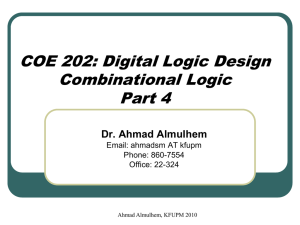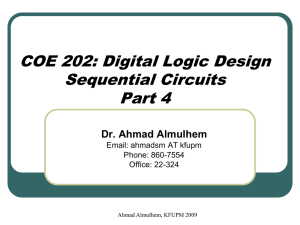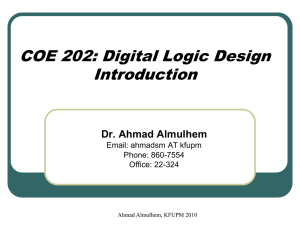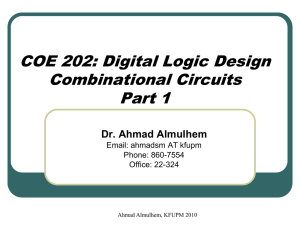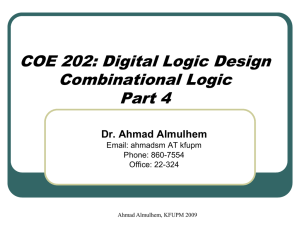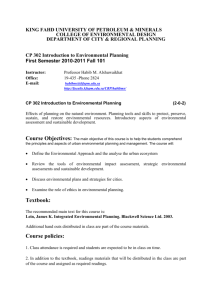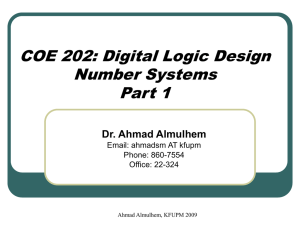COE 202: Digital Logic Design Number Systems Part 3
advertisement
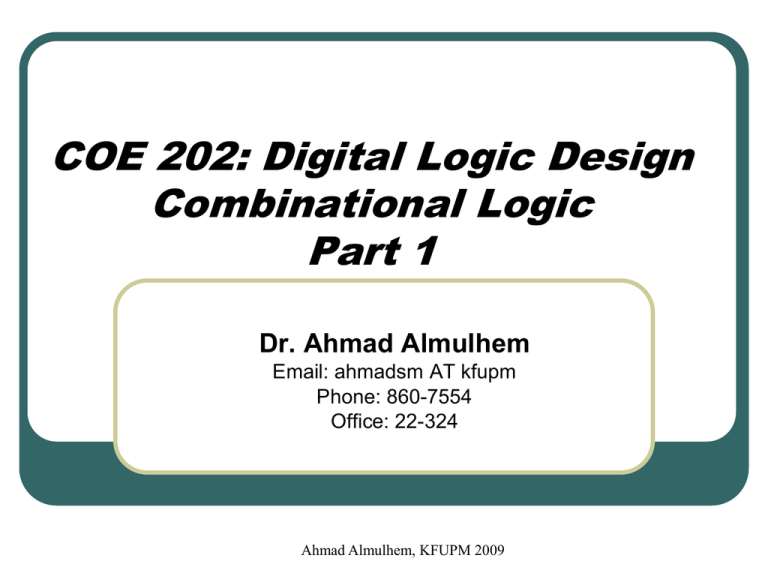
COE 202: Digital Logic Design Combinational Logic Part 1 Dr. Ahmad Almulhem Email: ahmadsm AT kfupm Phone: 860-7554 Office: 22-324 Ahmad Almulhem, KFUPM 2009 Objectives • • • • • Boolean Algebra Boolean Expressions Boolean Identities Algebraic manipulation (simplification) Complement of a Function Ahmad Almulhem, KFUPM 2009 Introduction • Digital circuits are hardware components for processing (manipulation) of binary input • They are built of transistors and interconnections in semiconductor devices called integrated circuits • A basic circuit is called a logic gate; its function can be represented mathematically. • What is inside the gate is not of concern to the system/computer designer (Only its function) • Binary logic (Boolean Algebra) is a mathematical system to analyze and design digital circuits – George Boole (introduced mathematical theory of logic in1854) Ahmad Almulhem, KFUPM 2009 Boolean Algebra Regular Algebra Boolean Algebra Values Numbers Integers Real numbers Complex Numbers 1 (True, High) 0 (False, Low) Operators +, -, x, /, … etc AND ( . ) OR (+) NOT ( ‘, ) Variables may be given any name such as A, B, X etc.. Ahmad Almulhem, KFUPM 2009 Logical Operations Three basic logical operations can be applied to binary variables: AND: Z = X.Y or Z = XY The AND operation works as follows: If both X and Y have a value of 1, the output Z will be 1 else Z will be 0 OR: Z = X + Y The OR operation implies: If either X or Y have a value of 1, the output Z will be 1 NOT: Z = X If the value of X is a 0, Z is a 1, and if X = 1, Z= 0 Don’t confuse binary logic and binary arithmetic ! Ahmad Almulhem, KFUPM 2009 AND Operation A truth table of a logical operation is a table of all possible combinations of input variable values, and the corresponding value of the output The truth table for the AND logical operation: AND X Y Z = X.Y 0 0 0 0 1 0 1 0 0 1 1 1 Ahmad Almulhem, KFUPM 2009 Similar to multiplication AND Gate The electronic device that performs the AND operation is called the AND gate X Z Y An AND gate with two input variables X, Y and one output Z Note: The output of the AND gate Z is a 1 if and only if all the inputs are 1 else it is 0 Ahmad Almulhem, KFUPM 2009 3-input AND gate Truth Table for a 3 input AND gate W X Z Y Note: For an n-input logic gate, the size of the truth table is 2n W X Y Z 0 0 0 0 0 0 1 0 0 1 0 0 0 1 1 0 1 0 0 0 1 0 1 0 1 1 0 0 1 1 1 1 Ahmad Almulhem, KFUPM 2009 OR Operation The truth table for the OR logical operation OR X Y Z = X +Y 0 0 0 0 1 1 1 0 1 1 1 1 Ahmad Almulhem, KFUPM 2009 Similar to addition OR Gate The electronic device that performs the OR operation is called the OR gate X Y Z An OR gate with two input variables X, Y and one output Z Note: The output of the OR gate Z is a 1 if either of the two inputs X, Y are 1 Ahmad Almulhem, KFUPM 2009 OR Gate – 3 Input Truth Table for a 3 input OR gate W X Z Y Note: For an n-input logic gate, the size of the truth table is 2n W X Y Z=W+X+Y 0 0 0 0 0 0 1 1 0 1 0 1 0 1 1 1 1 0 0 1 1 0 1 1 1 1 0 1 1 1 1 1 Ahmad Almulhem, KFUPM 2009 NOT Operation •NOT is a unary operator, meaning there can only be 1 input •The NOT operation can be represented as follows: Z= X’ or Z=X •X is also referred to as the complement of Z. •The NOT gate is also known as the Inverter NOT X Z X Z=X 0 1 1 0 Ahmad Almulhem, KFUPM 2009 Timing Diagram time time time time time Ahmad Almulhem, KFUPM 2009 Boolean Expression F (X, Y) = XY + Y’ variable • • • • • operator literals A Boolean expression is made of Boolean variables and constants combined with logical operators: AND, OR and NOT A literal is each instance of a variable or constant. Boolean expressions are fully defined by their truth tables A Boolean expression can be represented using interconnected logic gates – Literals correspond to the input signals to the gates – Constants (1 or 0) can also be input signals – Operators of the expression are converted to logic gates Example: a’bd + bcd + ac’ + a’d’ (4 variables, 10 literals, ?? gates) Ahmad Almulhem, KFUPM 2009 Operator Precedence • • Given a Boolean expression, the order of operations depends on the precedence rules given by: 1. Parenthesis Highest Priority 2. NOT 3. AND 4. OR Lowest Priority Example: XY + WZ will be evaluated as: 1. XY 2. WZ 3. XY + WZ Ahmad Almulhem, KFUPM 2009 Example F = X . ( Y’ + Z) This function has three inputs X, Y, Z and the output is given by F As can be seen, the gates needed to construct this circuit are: 2-input AND, 2-input OR and one NOT Y’ Y X Z Ahmad Almulhem, KFUPM 2009 F Example (Cont.) A Boolean function can be represented with a truth table F = X . ( Y’ + Z) X Y Z Y’ Y’ + Z F=X.(Y’+Z) 0 0 0 1 1 0 0 0 1 1 1 0 0 1 0 0 0 0 0 1 1 0 1 0 1 0 0 1 1 1 1 0 1 1 1 1 1 1 0 0 0 0 1 1 1 0 1 1 Ahmad Almulhem, KFUPM 2009 Identities of Boolean Algebra Ahmad Almulhem, KFUPM 2009 Duality Principle • • The principle of duality states that: given a Boolean Algebra identity, its dual is obtained by replacing all 1’s with 0’s and 0’s with 1’s, all AND operators with OR, and all OR operators with AND The dual of an identity is also an identity AND Identities: Replacing OR Identities (Dual): X.1 = X 1 with 0 X+0=X X.0 = 0 0 with 1 X+1=1 X.X = X + with . X+X=X X.X = 0 . with + X+X=1 Another Important Identity: X = X Ahmad Almulhem, KFUPM 2009 DeMorgan’s Theorem X Y X Y X Y X Y use truth tables to prove that two Boolean expressions are equal ! Extended DeMorgan’s Theorem: X1 + X2 + …. +Xn = X1.X2…..Xn X1 X2 …. Xn = X1 + X2+….+Xn Ahmad Almulhem, KFUPM 2009 Why Boolean Algebra? • Boolean algebra identities and properties help reduce the size of expressions • In effect, smaller sized expressions will required fewer logic gates for building the circuit • As a result, less cost will be incurred for building simpler circuits • The speed of simpler circuits is also high Ahmad Almulhem, KFUPM 2009 Algebraic Manipulation Ability to use the Boolean identities and properties to reduce complex equations Example 1: Prove that X + XY = X X + XY = X.(1+Y) = X.1 = X (using the distributive property, and the identities (X + 1=X, X.1=X) Example 2: Reduce X+X’Y = (X+X’).(X+Y) = 1.(X+Y) = X+Y Ahmad Almulhem, KFUPM 2009 Algebraic Manipulation (Example) F = X’YZ + X’YZ’ + XZ = X’Y(Z+Z’) + XZ (id 14) = X’Y.1 + XZ (id 7) = X’Y + XZ (id 2) Ahmad Almulhem, KFUPM 2009 Examples Show that XY + X’Z + YZ = XY + X’Z LHS = XY+X’Z+YZ = XY+X’Z+YZ.1 = XY+X’Z+YZ(X+X’) = XY+X’Z+XYZ+X’YZ = XY+XYZ+X’Z+X’YZ = XY(1+Z)+X’Z(1+Y) = XY.1 + X’Z.1 = XY + X’Z = RHS Adding an extra step to acquire the desired output Ahmad Almulhem, KFUPM 2009 Examples (Homework) Reduce F1=(A + B + AB) (AB + AC + BC) Using DeMorgan’s Theorem, F1 = (A’.B’’.(AB)’).((AB)’.(A’C)’.(BC)’) = (A’.B.(A’+B’)).(A’+B’).(A+C’).(B’+C’) = (A’.B.A’ + A’.B.B’).(A’+B’).(A+C’).(B’+C’) = (A’.B.A’ + A’.B.B’).(A’+B’).(A+C’).(B’+C’) = (A’B + 0).(A’+B’).(A+C’).(B’+C’) = (A’BA+A’BC’)(B’+C’) = (A’BA’ + A’BB’) (A+C’).(B’+C’) = (0+A’BC’)(B’+C’) = (A’BA’ + A’BB’) (A+C’).(B’+C’) = (A’BC’B’ + A’BC’C’) = (A’B).(A+C’).(B’+C’) = (0 + A’BC’) = A’BC’ Ahmad Almulhem, KFUPM 2009 Examples (Homework) Simplify G = ((A+B+C).(AB+CD))+(ACD) = ((A+B+C)+(AB.(C+D))).ACD = (A+B+C).ACD + (AB.(C+D)).ACD = (ACD+ABCD) + (ABCD+ABCD) = (ACD +ACD(B+B) + ABCD) = (ACD + ACD + ABCD) = (ACD + ABCD) = (ACD(1+B)) = ACD Ahmad Almulhem, KFUPM 2009
